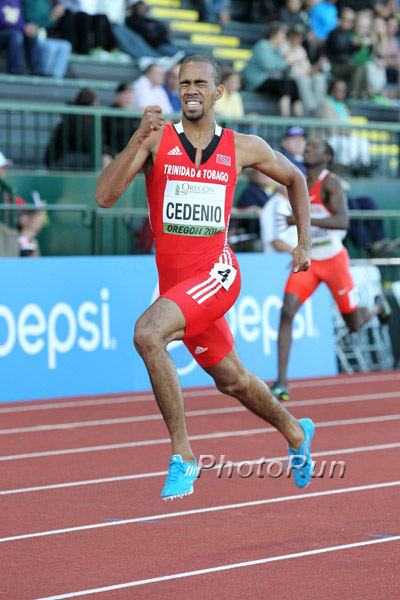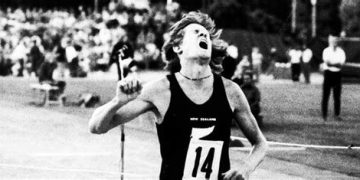The World Juniors are a celebration of young promise in our sport. That does not mean, however, that success as a World Junior guarantees success at the senior level. Elliott Denman looks at the numbers. An interesting perspective….
Machel Cedenio, photo by PhotoRun.net
JUNIOR WORLDS COLUMN
By ELLIOTT DENMAN
Don’t ever call the World Junior Championships the World Junior Olympics.
Don’t even try.
Sure the temptation is there – to call the event that has been raging at Hayward Field in Eugene a direct, almost sureshot stepping stone to the next scheduled Olympic Games, Rio de Janeiro in 2016 and Tokyo in 2020 – but our best advice is that you don’t get carried away by this premise.
The history is there to show it’s just not so.
For a myriad of reasons, those 19-and-unders who’ve led the world since the World Junior Championships were first staged in Athens in 1986, have had only intermittent success raising their games to “the next level.”
Most certainly so for the American 19-and-unders who were precocious enough and fortunate enough to collect individual gold medals at the 14 previous editions of the World Juniors. Success leading the world as ultimate teen-aged titlists was rarely followed by ultimate adult success
(which by our definition was leading the World in an individual event, at the Olympic Games or the World Championships, and excluding relays.)
The odds are long against it happening.
Sure, 5 did it. But 41 did not.
Check ’em out, check ’em out.
In those 14 previous World Juniors, a total of 46 Americans collected individual gold medals, broken down as follows:
100 Meters, 3 men, 5 women.
200 Meters, 3 men, 2 women.
400 Meters, 6 men, 3 women.
800 meters, 0 men, 1 woman.
1,500, 3,000, 5,000 and 10,000 meters, 3,000 steeplechase,0 men, 0 women.
110 hurdles/ 100 hurdles, 2 men, 4 women.
400 hurdles, 4 men, 2 women.
Racewalking, 5,000 and 10,000 meters, 0 men, 0 women.
High Jump, 1 man, 0 women.
Pole Vault, 0 men, 0 women.
Long Jump, 3 men, 0 women.
Triple Jump, 0 men,0 women.
Shot Put, 1 man, 1 woman.
Discus, 2 men, 0 women.
Hammer, 2 men, 0 women.
Javelin, 0 men, 0 women.
Decathlon/heptathlon 1 man, 0 women.
The totals: 28 men, 18 women.
Starting from the top:
The 5 of those 46 who went on to take individual (again, remember, non-relay) Olympic or World Championship golds:
(a) Adam Nelson (World Junior SP champion in 1994, he earned Olympic gold in 2004, although it took nearly a decade for him to actually get the medal.)
(b) LaShawn Merritt (World Junior 400 champion in 2004, he took the Olympic
gold in 2008.)
(c) Aries Merritt (World Junior 110HH champion in 2004, he earned Olympic gold in 2012.)
(d) Kerron Clement (World Junior World 400H champion in 2004, he took World Championships golds in 2007 and 2009.)
(e) Lashinda Demus (World Junior 400H champion in 2002, she won World Championships gold in 2011.)
Of course, the book is still open on many – certainly such current and still-surely-on-the-rise notables as Michelle Carter (World Junior SP champion in 2004) and Ajee’ Wilson (World Junior 800 champion 2012.)
Plus veteran Team USA standout Natasha Hastings (World Junior 400 champion 2004; Olympic 4×400 gold medalist 2008.)
But who knows how far the talents of Gunnar Nixon (World Junior decathlon champion 2012) and Eric Futch (World Junior 400H champion 2012) will take them? Likewise for Stormy Kendrick (World Junior women’s 200 champion 2010) and Ashley Spencer (World Junior 400 champion 2012.)
There, too, are the special cases of Lauryn Williams (World Junior 100 champion 2002) who ran/pushed her way to both Summer and Winter Olympics, and Marquise Goodwin (World Junior LJ champion 2008 and 2012 Olympian) who chose the NFL and now is a Buffalo Bills wide receiver and kick receiver.
So that still leaves 32 others.
Many really did go on to make major noise in the sport, and several are still competing at world-class levels….but yet have never earned individual (let me again emphasize non-relay) invitations to the top rung of Olympic and World Championship podiums.
These men have included Andre Cason (World Junior 100 champion 1988), Ivory Williams (100 2004), Kevin Braunskill (200 1988), Chris Nelloms (400 1990), Deon Minor (1992), Darrold Williamson (400 2002), Marcus Boyd (400 2008), Antwon Hicks (110HH 2002), Jeshua Anderson (400H 2008), Andra Manson (HJ 2002), Casey Malone (DT 1996), Walter Henning (HT 2008) and Conor McCullough (HT 2010.)
The American women in that category include Jeneba Tarmoh (2008), Shalonda Solomon (200 2004) and Monique Henderson (400 2002.)
And then there’s the roster of those others 16 who (for a myriad of reasons) fell short of their sport’s ultimate honors.
These Junior men: Derrick Florence (World Junior 100 champion 100 1986), Stanley Kerr (200 1986), Tony Wheeler (200 1994), Obea Moore (400 1996), Kelly Carter (400H 1988), Chris Carter (400H 2006), James Stallworth (LJ 1990). Neil Chance (LJ 1992) and Brian Milne (DT 1992, who, like Goodwin, chose the NFL life.)
The Junior women: Sabrina Kelly (100 1994), Shakedia Jones (1998), Ashley Owens (100 2004). Joyce Bates (100H 1996), Ronetta Alexander (100H 2004),
Teona Rodgers (100H 2008) and Takecia Jameson (400H 2008.)
Looking beyond the USA, the roster of past Junior World champions does include the likes of Javier Sotomayor and Colin Jackson (1986),Wang Junxia (1992), Veronica Campbell (2000), Blanka Vlasic (2000 and 2002), Valerie Adams (2002), David Rudisha (2006), Bogdan Bondarenko, David Storl and Teddy Tamgho (2008) and Genzebe Dibaba (2010.)
They proved themselves as teens and kept moving up every step of the global track and field ladder. Well and good, but please remember that for every one who climbed to the ultimate heights, a very long list of others never got far beyond that first big rung.
Larry Eder has had a 52-year involvement in the sport of athletics. Larry has experienced the sport as an athlete, coach, magazine publisher, and now, journalist and blogger. His first article, on Don Bowden, America's first sub-4 minute miler, was published in RW in 1983. Larry has published several magazines on athletics, from American Athletics to the U.S. version of Spikes magazine. He currently manages the content and marketing development of the RunningNetwork, The Shoe Addicts, and RunBlogRun. Of RunBlogRun, his daily pilgrimage with the sport, Larry says: "I have to admit, I love traveling to far away meets, writing about the sport I love, and the athletes I respect, for my readers at runblogrun.com, the most of anything I have ever done, except, maybe running itself." Also does some updates for BBC Sports at key events, which he truly enjoys. Theme song: Greg Allman, " I'm no Angel."
View all posts






















